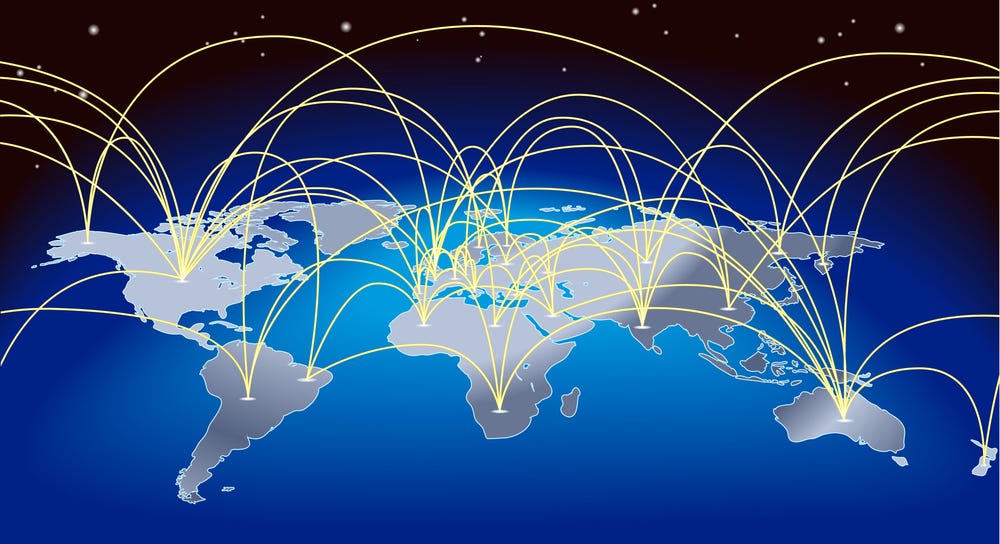The American-backed global trade system is the best world order that has ever been
The realistic alternatives are pretty grim.
The following is an excerpt from my second book Promoting Progress: A Radical New Agenda to Create Abundance for All. You can order e-books at a discounted price at my website, or you can purchase full-price ebooks, paperback, or hardcovers on Amazon.
Other books in my “From Poverty to Progress” book series:
I recommend reading my previous post on the global trade system before you read this post.
Whether coming from the socialist Left or the nationalist Right, the global trade system is blamed for a significant portion of the world’s problems. Some blame the global trade system for oppressing developing countries, while others blame it for unemployment and stagnant wages in wealthy nations.
Notice, however, that none of the critics of the current system spend any real thought on what the actual alternatives to our current system are. It is quite possible that, despite its problems, the current global trade system is the best world order that has ever existed.
More importantly, the realistic alternatives are pretty grim.
One of the great achievements of our current global trade system is that they have dramatically shifted the incentives of political and economic elites from expropriating wealth from the masses to creating wealth. This has shifted the world from zero-sum military competition to positive-sum economic competition.
If we survey human history, we can see that elite incentives have radically changed.
Phase 1: Political elites oppose innovation: Between the invention of agriculture and the Industrial Revolution, elites largely opposed innovations that were necessary to create economic growth. They did so because they feared innovations would create economic wealth for those who might challenge political elites in the future. Elites in agricultural regimes preferred to live in a poor nation with them in total control compared to a richer nation that they did not control. Life was zero-sum.
Phase 2: Political elites promote the copying of innovations to promote economic growth, but only when it enhances their military power: Then political elites gradually realized that technological innovation and economic growth would help them to build powerful military machines. A powerful military would enable political elites to win in the zero-sum military struggle against other political elites. Leaders in less developed nations realized that they had to copy the innovations made in wealthier nations, to avoid falling behind their militaries.
From about 1200 to well into the early 20th Century, European political leaders gradually lost their aversion to innovation because they knew that they had no choice. They were still afraid of the future political consequences (and rightly so), but they knew that they had to keep up with other nations. In general, political leaders in Northwest Europe learned this lesson faster than political leaders in Eastern Europe. Not surprisingly, those leaders won most wars.
This view carried over into the totalitarian regimes of the 20th Century, including Fascist Italy, Nazi Germany, Imperial Japan, the Soviet Union, and Communist China. They all promoted economic growth, but only as long as it translated into military power.
Phase 3: Political elites promote the copying of innovations to promote economic growth to enhance their popular support: As political freedom and democratic governance spread within Northwest Europe and North America, elites were forced to take into account mass opinion. Copying innovations in wealthier nations and economic growth were critical for doing so.
With the radical reduction of security threats at the end of the Cold War, political elites shifted from zero-sum military competition to positive-sum economic growth. Even authoritarian leaders realized that they needed to give their people positive reasons to support them. Political leaders are still concerned that economic growth will lead to rival power sources, and they are still concerned about falling behind militarily, but these are now secondary to economics.
The global trade system is a powerful incentive for political elites remaining in phase 3. If that global trade system were to fall or be seriously disrupted, political elites would shift back into phases 1 and 2.
Let’s not let that happen.
The above was an excerpt from my second book Promoting Progress: A Radical New Agenda to Create Abundance for All. You can order e-books at a discounted price at my website, or you can purchase full-price ebooks, paperback, or hardcovers on Amazon.
Other books in my “From Poverty to Progress” book series:






"The global trade system is a powerful incentive for political elites remaining in phase 3. If that global trade system were to fall or be seriously disrupted, political elites would shift back into phases 1 and 2."
Very relevant to our times where politics is now dominated by those calling for trade restrictions of all kinds and flavors. It began with tariffs, but has spread to import restrictions, and increasingly export restrictions, investment restrictions and the like.
The world is bifurcating into two economic, political, and technological orders. I can see some possible silver linings to this. For example, the US efforts to block EUV lithography machines from being sold to China are forcing the country to experiment with free electron lasers and other alternative pathways to manufacturing chips. The paths China takes may ultimately be better.